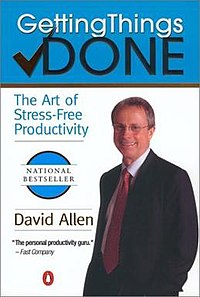Getting Things Done

Getting Things Done: The Art of Stress-Free Productivity cover, first edition
|
|
| Author | David Allen |
|---|---|
| Subject | Business |
| Publisher | Penguin |
|
Publication date
|
2001 |
|
Published in English
|
2001 |
| Pages | 267 |
| ISBN | (2015 Reprint Edition) |
| OCLC | 914220080 |
Getting Things Done is a time-management method, described in a book of the same title by productivity consultant David Allen. It is often referred to as GTD.
The GTD method rests on the idea of moving planned tasks and projects out of the mind by recording them externally and then breaking them into actionable work items. This allows one to focus attention on taking action on tasks, instead of on recalling them.
First published in 2001, a revised edition of the book was released in 2015 to reflect the changes in information technology during the preceding decade and incorporate recent scientific research supporting the system's claims regarding how the mind functions.
Allen first demonstrates stress reduction from the method with the following exercise, centered on something that has entered your life that has an unclear outcome or where the next action is not defined. (Allen calls these sources of stress "open loops," "incompletes," or "stuff.")
He claims stress can be reduced and productivity increased by putting reminders about everything you are not working on into a trusted system external to your mind. In this way, you can work on the task at hand without distraction from the "incompletes." The system in GTD requires you have within easy reach an inbox, a trash can, a filing system for reference material, several lists (detailed below), and a calendar. These tools can be physical or electronic as appropriate (e.g. a physical "in" tray or an email inbox). As "stuff" enters your life, it is captured in these tools and processed with the following workflow.
The GTD workflow consists of five stages: capture, clarify, organize, reflect, and engage. (The first edition used the names collect, process, organize, plan, and do; the descriptions of the stages are similar in both editions). Once all the material ("stuff") is captured (or collected) in the inbox, each item is clarified and organized by asking and answering questions about each item in turn as shown in the black boxes in the logic tree diagram. As a result, items end up in one of the eight oval end points in the diagram:
Empty your inbox or inboxes daily or at least weekly ("in" to empty). Don't use your inbox as a "to do" list. Don't put clarified items back into the inbox. Emptying your inbox doesn't mean finishing everything. It just means applying the "capture, clarify, organize" steps to all your "stuff."
Next, reflection (termed planning in the first edition) occurs. Multi-step projects identified above are assigned a desired outcome and a single "next action." Finally, a task from your task list is worked on ("engage" in the 2nd Ed, "do" in the 1st Ed) unless the calendar dictates otherwise. You select which task to work on next by considering where you are (the "context", e.g. at home, at work, out shopping, by the phone, at your computer, with a particular person), time available, energy available, and priority.
...
Wikipedia
